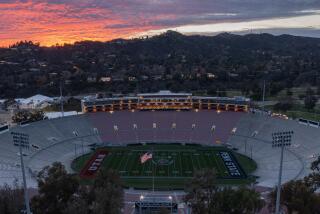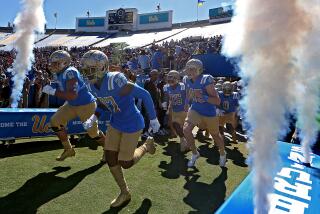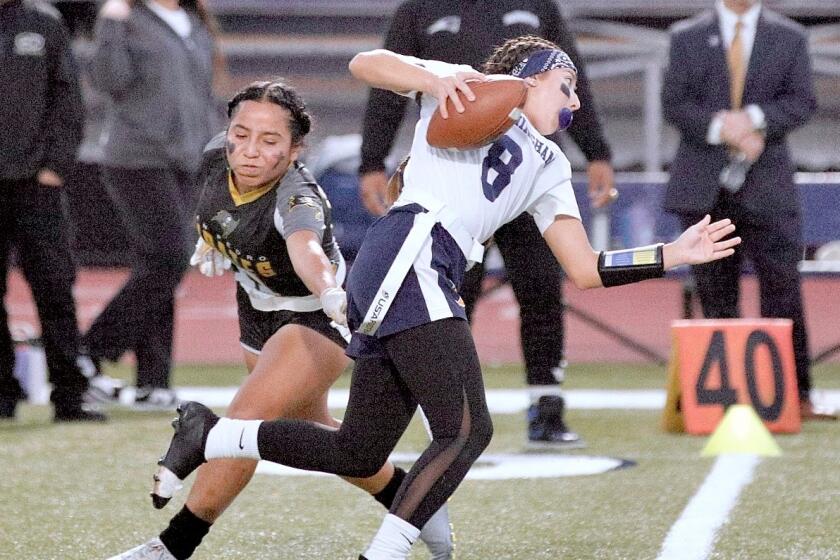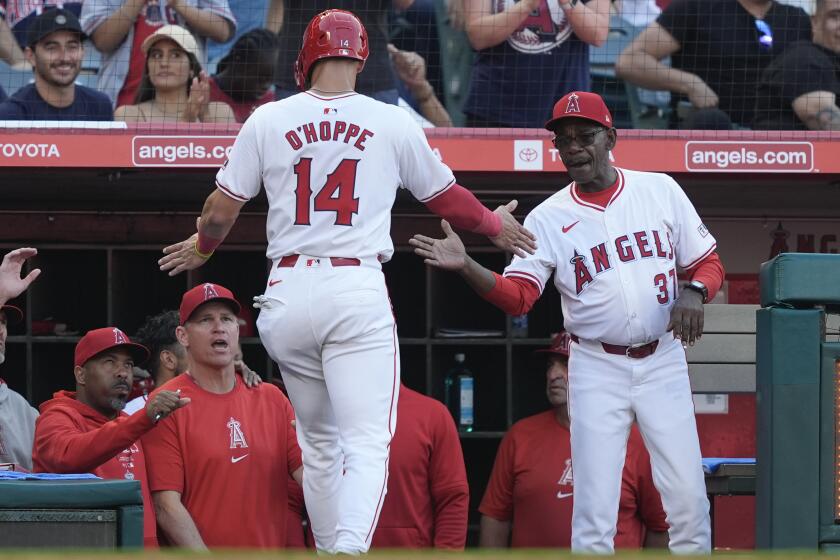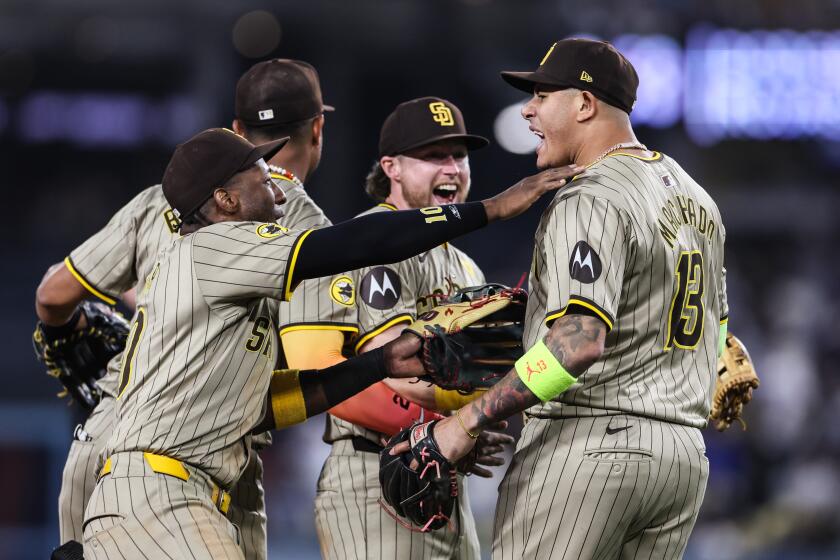For the best in bowls, the subject is Roses
The Rose Bowl was born a year before the flight at Kitty Hawk and was still kicking last year as Endeavor crawled through the streets of Los Angeles on the way to its final resting spot.
Between the Rose’s first bloom in 1902 and this year’s 100th game, a plane covered a few hundred feet and a space shuttle covered 122 million miles.
Time and the Granddaddy march on.
The Rose Bowl has endured, lurched, gurgled, bellowed and expanded. It has hosted triumph and defeat and made it through two world wars, the stock market crash, a Great Depression, the Cold War, Woody Hayes and the Bowl Championship Series.
The game changed — first over radio, then on television — the demographics of the United States. Print, audio and television-relayed images of sun splash spawned migration from a hunkered-down East.
Jim Murray, the Pulitzer Prize-winning sports columnist for The Times, suggested the Rose Bowl had as much to do with our population growth as the railroad system.
“Ask anybody back in the ‘20s what came to mind when they thought about Los Angeles and the answer would come back, without hesitation, ‘Charlie Chaplin and the Rose Bowl,’” Murray wrote.
Murray opined that some coaches “stepped up their cheating” just to get here, and maintained our metropolis was settled, in part, by “a slow leak in Iowa.”
The Rose Bowl excels at sunsets and symmetry.
Michigan won the first game, 49-0 over Stanford, with fullback Neil Snow scoring the first points on a six-yard run. The most recent points, tallied last Jan. 1, came on a 22-yard field goal by Stanford’s Jordan Williamson.
A popular national radio host, not from the West, recently wondered out loud why the Rose Bowl was so special. He should have asked Art Spander, the longtime Bay Area sports columnist, who this week will celebrate his 61st straight trip to the Rose Bowl.
Spander, 75, has attended every Rose Bowl since 1954.
The streak started innocently enough, when Spander was a boy growing up in Los Angeles and his father suggested Art could make extra money selling programs at the Rose Bowl.
Spander says he earned 10 bucks during Michigan State’s victory over UCLA in the 1954 game. He kept the streak alive as a student at UCLA and then, for more than five decades, as a sportswriter in Los Angeles and the Bay Area.
“I just think sitting there is the greatest thing in the world,” Spander said during a recent phone interview. “Watching the sun start to set about 4 o’clock, and the shadows falling, with the game going on. It’s a great place to be. “
The Rose Bowl is special, first and foremost, because it was first. In fact, it was the only bowl game for decades.
It has known ups and downs and occasionally even fumbled.
The event, which was started as an adjunct to the Rose Parade, was canceled after the 1902 game because of dangerous play and unruly crowds.
It was replaced by chariot ostrich races. An early advertisement for the Cawston Ostrich Farm encouraged patrons to “stop at the Farm and see the Ostriches Plucked.”
The 1913 post-parade entertainment, as recounted by Malcolm Moran in a new book celebrating the 100th Rose Bowl, included a race between an elephant and a camel.
Tournament of Roses President Lewis Turner established a committee to bring back football “so Pasadena can give the newspapermen from coast to coast something exciting to write about.”
The Rose Bowl game returned in 1916 and has continuously served as a repository for the human spirit and condition. It has been affected by war but not stopped by it.
During World War I, at President Woodrow Wilson’s urging, the Rose Bowl continued with military teams replacing depleted college squads. The 1919 game featured George “Papa Bear” Halas leading Great Lakes Navy over the Mare Island Marines.
The 1942 Rose Bowl was notably moved to Durham, N.C., just a few weeks after the Japanese bombed Pearl Harbor. Fear of aerial attacks prohibited large gatherings on the West Coast.
The game healed and it humbled.
“The Rose Bowl was the wrong place to make a mistake,” Murray once wrote.
California center Roy Riegels found out in 1929 when he ran the wrong way with a fumble and cost his team in an 8-7 loss to Georgia Tech.
The man forever tattooed as “Wrong Way Roy” was labeled by one newspaper as the “bonehead of his era.”
Yet, in later years, Riegels told the Pasadena Star the blunder made him a better person. “I gained true understanding of life from my Rose Bowl mistake,” he said. “I learned you can bounce back from misfortune and view it as just something adverse that happened to you.”
Rose Bowl history has reshaped college football history.
The 1925 game helped establish Notre Dame as a preeminent national power and featured the last ride of the fabled “Four Horsemen.”
Notre Dame Coach Knute Rockne used the cross-country train trip to proselytize faith, family and football. The Fighting Irish then defeated Stanford, coached by Pop Warner, to cap a 10-0 season and a national championship.
The Times’ Paul Lowry, writing in the day’s flowery prose, described how “gold lurked in the rock-ribbed ledges of the mountains purpling in the rays of a descending sun.”
One newspaper story in advance of the 100th game cannot possibly encapsulate all the memories. The other bowls combined could live off the Rose’s table scraps.
The Rose Bowl this fall impaneled a group of college football aficionados to choose an All-Century team. You should have seen the names they left off.
The panel named USC’s John McKay as the all-century coach and Ohio State’s Archie Griffin as the all-century player. Griffin celebrated freshman eligibility in the early 1970s by starting in four straight Rose Bowls.
The game was first called “Rose Bowl” in 1923 and first broadcast on local radio in 1926.
In Alabama’s 1935 win over Stanford, Crimson Tide quarterback Dixie Howell hit receiver Don Hutson for six passes that the newspaper said flew “like arrows from Robin Hood’s trusty bow.”
Stanford’s “Vow Boys” of the 1930s kept their promise of never losing again to USC after a frosh-team loss in 1932, but lost Rose Bowl games to Columbia and Alabama before beating Southern Methodist in 1936.
In 1947, the Pacific and Big Ten conferences began a compact that went uninterrupted until a contract with the BCS created the 2002 national title game pitting Nebraska and Miami.
“That,” purists like Art Spander still say, “was not the Rose Bowl.”
The stories, footnotes, and characters flow like the rain that nearly washed out the 1934 game and so annoyed Ohio State Coach Hayes in 1955.
Hayes began his love-hate relationship with Pasadena that year by ripping the bands for marching on the muddy field. “Eighty million people saw the bands on TV in the parade this morning,” Hayes grumbled. “So why did they have to march on that muddy field at the half?”
It has not rained, significantly, since.
You’d need the entire Sunday edition for a full story on the first 99 games.
Who could forget Doyle Nave, a fourth-string quarterback, leading USC to a 7-3 win over Duke in 1939? Nave’s 19-yard scoring pass to Al Krueger in the final minute were the first points Duke had given up all season.
There was the 1963 the game in which quarterback Ron Vander Kelen nearly led Wisconsin back from a 42-14, fourth-quarter ditch.
USC hung on to win the national title, even if Murray later remembered of the game: “Wisconsin won it, 37-42.”
The Rose Bowl is closing in on 100 games of Elmer “Gloomy Gus” Henderson, Earle “Greasy” Neale, “Tricky Dick” Hyland and “Wrong Way” Roy.
They’ve shared the ride with “Hopalong” Cassady, “Bear” Bryant, “Bones” Hamilton, “Biggie” Munn and the apocalyptic aliases: Famine, Pestilence, Destruction and Death.
The game evokes memories of ghosts and Charles White’s phantom touchdown, against Michigan, in 1979. There was even an earthquake during that game.
Caltech didn’t participate in the 1961 game, but its prankster geniuses won the halftime by fixing the card show to spell out their school’s name.
In 1967, Murray praised McKay for going for two in USC’s 14-13 loss to Purdue. “Don’t die hiding in the closet,” Murray wrote.
Bo Schembechler, the late Michigan coach, didn’t make it to the 1970 game after suffering a heart attack. He insisted to the doctors at St. Luke’s Hospital he would coach until “next thing I know I have a needle jammed in my arm and I’m out of the game.”
Murray would joke Bo should have stayed in bed. Schembechler lost five Rose Bowls before winning his first in 1981.He finished with a record of 2-8 overall, yet loved the Rose Bowl as much as he hated what the commissioners had done to it.
“Just let it run out,” he said of the BCS contract before the 2004 Rose Bowl, “that would suit me fine.”
There is no place to park on Rose Bowl’s memory lane.
UCLA shockingly denied No.1 Ohio State the national title in 1976 and, in 1997, Ohio State denied Arizona State the national title.
Top-ranked Michigan, led by Heisman winner Charles Woodson, claimed the Associated Press crown with a win over Washington State in 1998.
USC, ranked first in every reputable index except the BCS standings in 2003, missed out on the BCS title game but grabbed an AP share by winning the 2004 Rose Bowl.
The BCS-era Rose Bowl produced nontraditional champions Miami, Alabama and Texas, which in 2006 defeated USC in one of the greatest college football games ever played.
Wasn’t Vince Young brilliant? After Texas stopped USC on fourth and two — with Reggie Bush on the bench, Young scored his third touchdown on fourth and five.
The first 99 Rose Bowls deserve 99 more.
The game has provided dizzying high points and a few lows, maybe none lower than Miami against Nebraska on a Thursday night two days after the parade.
“Didn’t watch it,” Schembechler once remarked when asked what he thought of that Rose Bowl.
There are other bowls and other days, but only one bowl was first on the first.
More to Read
Go beyond the scoreboard
Get the latest on L.A.'s teams in the daily Sports Report newsletter.
You may occasionally receive promotional content from the Los Angeles Times.
